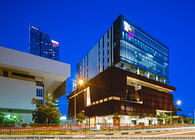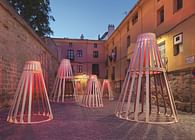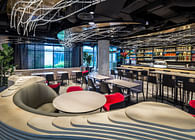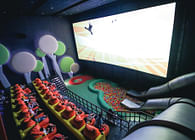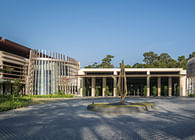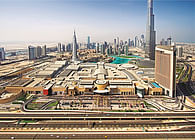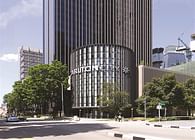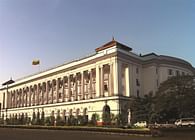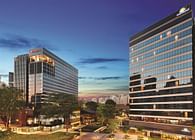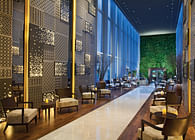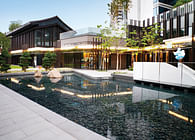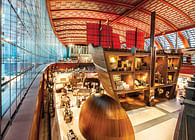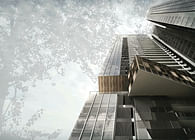
Singapore, SG
Situated at the heart of the 200ha one-north development hub at Buona Vista, among clusters of world-class research facilities and business parks, is the newly completed Four Acres Singapore. Perched on top of Nepal Hill and occupying a sprawling site of 2.3ha, Four Acres Singapore is global consumer goods giant Unilever’s newest leadership development facility and also Singapore’s first corporate university of this scale.
Unilever – known for brands like Wall’s, Knorr, Dove and Ponds – set up its first leadership development centre in London over 60 years ago. The plan for Four Acres Singapore, the first outside of Britain, is to continue the tradition of Four Acres London. It is a campus that houses talents and trains them to be top leaders in the company. This time, though, the leaders-to-be will become more attuned to the rapidly growing and emerging Asian economies and high-growth developing markets as Unilever plans to double the size of its business, while halving its environmental footprint and increasing its positive social impact. Hence, it follows that Unilever’s design brief for Four Acres Singapore was to ensure that the project achieves the BCA Green Mark Platinum certification.
In terms of academic courses, world-class institutions such as the Harvard Business School, INSEAD and Singapore Management University are some of the partners that helped develop the campus programmes.
A LOCATION STEEPED IN HISTORY
Nestled in a tree conservation area, the site is thick with history. Other than the newly proposed four-storey training block and a single-storey recreation block, there are ten conserved black-and-white colonial bungalows within the compound – this provided an interesting historical backdrop to the proposed buildings that were eventually erected.
A check on the Urban Redevelopment Authority website on local built heritage reveals that Nepal Hill and the adjacent Rochester Park were developed by the British in the late 1930s within the greater British Military Area (the Alexandra district) to house officers and their families.
Nepal Hill was named in recognition of the British Crown’s ties with the sovereign country of Nepal. The Gurkha regiment in Singapore, led by British officers, were stationed in Slim Barracks at the foot of the hill. The Gurkhas, recruited from Nepal, were famed for their fighting prowess and their loyalty to the British Crown. The bungalows at Nepal Hill served as family accommodation for the British officers of the regiment. The area was given conservation status in March 2010.
Today, top leaders from Unilever companies all over the world are being housed within these conserved buildings during their training programmes. Nine out of ten conserved bungalows have been refurbished for adaptive reuse as on-site accommodation; the remaining has been retrofitted to become a cafeteria, providing an alternative venue to the seminar rooms for discussions among the participants.
SITE-SPECIFIC AND RESPECTFUL DESIGN
Nepal Hill is preserved as a major green lung central to the surrounding research facilities and business parks, as envisioned in Zaha Hadid’s one-north master plan. Hence, in the overall planning strategy of the development, it was crucial that the existing mature trees and flora were preserved as much as possible to keep the original wooded environment as it was.
The U-shaped form of the training centre demonstrates the environmental consciousness of the design: the building form attempts to fit within the existing clearing, meandering around clusters of mature trees along its way and working its path around the flora. The result is a unique shape that is site-specific and respectful of the natural surroundings.
Characterised by the unique and expressive roofscape within the master plan, the design of the buildings within Four Acres Singapore not only responds to the spirit of the master plan in its treatment of the roof form, the dynamic roof of the training centre also responds to the undulating contours of Nepal Hill. The architecture appears to peel gently from the earth.
The design of the new built structures demonstrates the unique relationship of the two buildings by interconnecting them together. The four-storey training block and single-storey recreation block are both independent and separate entities, yet intertwined. The design arranged for the bold gesture of the roof form at the training centre to sweep down and extend towards the adjacent recreation block. The architectural element transits and morphs to become the canopy of a footpath, and then transforms again to become a roof when it integrates with the recreation block. Visually, it forms an intriguing picture as the roof of one building transforms and transits into that of the other.
Moving beyond aesthetics, this interlocking relationship of building forms allows for a more utilitarian arrangement in services planning. Bridging the two independent buildings, the roof not only becomes a covered linkway between them, it also becomes an important infrastructure where electrical and mechanical provisions are transported from the main building to serve the recreation block.
The façade design of the new training centre pays tribute to its unique environment by incorporating colours and materials that respect the conserved bungalows. The training centre also has a full green roof which not only reduces heat gain for its interiors, but also acts as a green replacement for the building’s footprint.
Throughout the space planning for the training centre, the view into nature was capitalised at every turn. All seminar rooms were planned with a view either to the garden or the wooded environment. There is also the Harvard University-style amphitheatre at the second storey, which has been designed with an entire stretch of full-height glass windows at the back of the room. These rooms are basked in light at most times of the day, thereby reducing the need for artificial lighting. The toilets within the training centre were also sensitively designed to the same intent, with full-height glass windows that allow users to enjoy the stunning views of the greenery around the site.
Due to the natural topography of the site, half of the training centre’s first storey is at subterranean level. To be consistent with the central theme and not create an environment that is very introverted, skylights were introduced along the main interior circulation paths. In addition, the team designed a light shaft that channels natural light down to the underground level. At the same time, a cluster of sculptured trees at the centre of the light shaft provides greenery within the space. As the trees grow and extend beyond the first storey and into the external garden space at the second storey, the line between indoors and outdoors is blurred further.
The overall design strategy for Four Acres Singapore is simple – to respect the environment that it is sited in. The clarity of the circulation paths for pedestrian and vehicular access is distinct. The participant on the rush in the morning can take the direct stairway connection through the recreation block to the training centre; in the evening, he can take a leisurely walk along the planned nature trail back to his black-and-white bungalow. The charm of the heritage bungalows is maintained both at the exterior and interior; the design of the guestrooms resonates with the architectural expression of these elegant vestiges of Singapore’s colonial past.
Status: Built
Location: Singapore, SG
